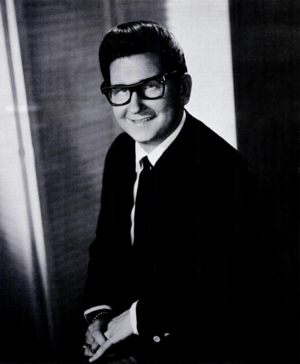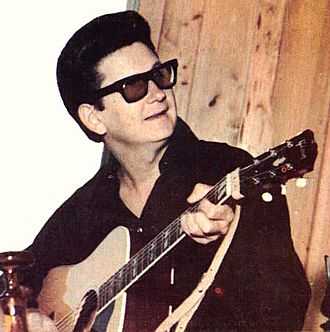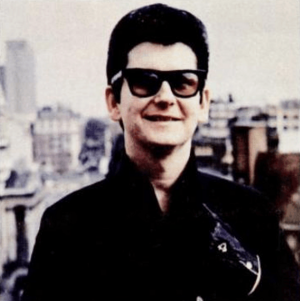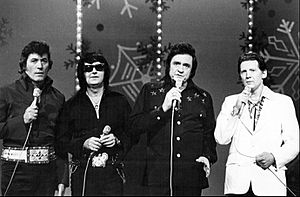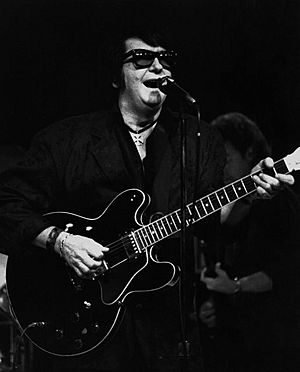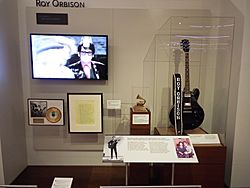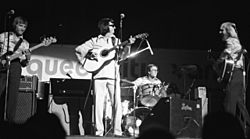Roy Orbison facts for kids
Quick facts for kids
Roy Orbison
|
|
|---|---|
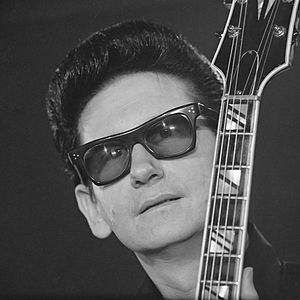
Orbison in 1965
|
|
| Background information | |
| Birth name | Roy Kelton Orbison |
| Born | April 23, 1936 Vernon, Texas, U.S. |
| Died | December 6, 1988 (aged 52) Hendersonville, Tennessee, U.S. |
| Genres | |
| Occupations |
|
| Instruments |
|
| Years active | 1953–1988 |
| Labels |
|
Roy Kelton Orbison (born April 23, 1936 – died December 6, 1988) was an American singer, songwriter, and musician. He was famous for his strong, emotional singing and unique songs. Critics often called his music "operatic," like an opera, which earned him nicknames like "The Caruso of Rock" and "The Big O." Many of his songs showed a sensitive side, which was different from other male rock-and-roll singers at the time. He usually performed standing still, wearing black clothes, with his dark hair and sunglasses.
Roy Orbison was born in Texas. As a teenager, he started singing in a rockabilly and country band. He signed with Sam Phillips of Sun Records in 1956. But his biggest hits came when he joined Monument Records. From 1960 to 1966, 22 of his songs made it into the Top 40 charts. He wrote or helped write most of his Top 10 hits. These included "Only the Lonely" (1960), "Running Scared" (1961), "Crying" (1961), "In Dreams" (1963), and "Oh, Pretty Woman" (1964).
After the mid-1960s, Orbison faced some sad personal events. His music career also slowed down. However, he became popular again in the 1980s. This happened after other artists covered his songs. In 1988, he formed a rock supergroup called the Traveling Wilburys. He was joined by George Harrison, Bob Dylan, Tom Petty, and Jeff Lynne. Roy Orbison died of a heart attack in December 1988 at age 52. One month later, his song "You Got It" (1989) was released. It became his first Top 10 hit in the US and UK in almost 25 years.
Orbison received many honors. He was inducted into the Rock and Roll Hall of Fame and Nashville Songwriters Hall of Fame in 1987. He also joined the Songwriters Hall of Fame in 1989 and the Musicians Hall of Fame and Museum in 2014. He received a Grammy Lifetime Achievement Award and five other Grammy Awards. Rolling Stone magazine ranked him high on their lists of "Greatest Artists" and "Greatest Singers."
Contents
- Roy Orbison's Early Life
- Early Music Career: Sun Records and Acuff-Rose
- Becoming a Star: Monument Records
- Later Years: Challenges and Comeback
- 1970s: Tough Times
- 1980–1988: Comeback and Final Years
- Roy Orbison's Death and Legacy
- Roy Orbison's Style and Impact
- Honors and Awards
- Images for kids
- See Also
Roy Orbison's Early Life
Roy Orbison was born on April 23, 1936, in Vernon, Texas. His family moved to Fort Worth in 1942. They were looking for work in aircraft factories. He went to Denver Avenue Elementary School there. But a scare about polio made the family move back to Vernon.
Roy's father gave him a guitar for his sixth birthday. Roy said he was "finished" with anything else after that. Music became the most important thing in his life. When he was young, country music was his main influence. He especially liked Lefty Frizzell's singing style. He even used the name "Lefty Wilbury" when he was with the Traveling Wilburys. He also enjoyed music by Hank Williams, Moon Mullican, and Jimmie Rodgers. One of the first musicians he heard live was Ernest Tubb. Tubb played on the back of a truck in Fort Worth. In West Texas, Roy also heard rhythm and blues, Tex-Mex, and Cajun music. "Jole Blon" was a Cajun song he sang publicly. He started singing on a local radio show at age 8. By the late 1940s, he was the show's host.
His family moved again in 1946, this time to Wink, Texas. Roy described life in Wink as "football, oil fields, oil, grease, and sand." He was glad to leave the lonely town later. All the Orbison children had poor eyesight. Roy wore thick glasses from a young age. He felt self-conscious about how he looked. He started dyeing his light hair black when he was young. He was a quiet, humble, and very polite person. But he always loved to sing. He thought his voice was memorable, but not amazing.
In high school, Roy and his friends formed a band called the Wink Westerners. They played country songs and Glenn Miller songs at local dance halls. They also had a weekly radio show on KERB in Kermit, Texas. They were paid $400 to play at a dance. Roy then realized he could make a living from music. He went to North Texas State College in Denton. He planned to study geology to work in oil fields if music didn't work out. But then he heard that his schoolmate Pat Boone had signed a record deal. This made him even more determined to be a professional musician. While in college, he heard a song called "Ooby Dooby." It was written by Dick Penner and Wade Moore. He took "Ooby Dooby" back to Wink and kept performing with the Wink Westerners. After his first year, he enrolled in Odessa Junior College. Two band members left, and two new ones joined. The group won a talent contest. They got their own TV show on KMID-TV in Midland. The Teen Kings kept playing on local TV, performed at dances, and went to college.
While living in Odessa, Roy saw Elvis Presley perform. Johnny Cash toured the area in 1955 and 1956. Cash appeared on the same local TV show as the Wink Westerners. He suggested that Roy contact Sam Phillips at Sun Records. Roy did, but Phillips told him, "Johnny Cash doesn't run my record company!" The success of their KMID TV show led to another show on KOSA-TV. They changed their name to the Teen Kings. They recorded "Ooby Dooby" in 1956 for the Je–Wel label. A record store owner played it over the phone for Sam Phillips. Phillips then offered the Teen Kings a contract.
Early Music Career: Sun Records and Acuff-Rose
The Teen Kings went to Sun Studio in Memphis. Phillips wanted to record "Ooby Dooby" again there. The song was released in May 1956. It reached number 59 on the Billboard Hot 100 chart. It sold 200,000 copies. The Teen Kings toured with famous artists like Sonny James, Johnny Horton, Carl Perkins, and Cash. Roy was very influenced by Elvis Presley. He performed with lots of energy. He did "everything we could to get applause." Roy also started writing rockabilly songs. These included "Go! Go! Go!" and "Rockhouse." The band eventually broke up over disagreements about song credits and money. But Roy stayed in Memphis. He asked his 16-year-old girlfriend, Claudette Frady, to join him. They stayed at Phillips' home. In the studio, Roy focused on how to record music. Phillips was more impressed with Roy's guitar playing than his singing. Roy wrote a slow song called "The Clown." But it didn't do well. After hearing it, Sun Records producer Jack Clement told Roy he would never be a successful ballad singer.
Roy met Elvis Presley's friends. He even once picked up a date for Presley in his purple Cadillac. Roy wrote "Claudette" about Claudette Frady. He married her in 1957. The Everly Brothers recorded "Claudette" as the B-side of their hit "All I Have to Do Is Dream." The first money Roy earned from Sun Records helped him buy his own Cadillac. He became frustrated with Sun Records and stopped recording there. He toured around Texas. Then he stopped performing for seven months in 1958.
For a short time in the late 1950s, Roy worked at Acuff-Rose. This company focused on writing country music songs. After writing a song all day, he would make demo tapes. He sent them to Wesley Rose, who tried to find other musicians to record them. Roy tried to sell his recordings of other writers' songs to RCA Victor. He worked with Chet Atkins, who played guitar with Presley. One song he tried was "Seems to Me." The writer, Boudleaux Bryant, remembered Roy as "a timid, shy kid." Bryant said Roy seemed "rather befuddled by the whole music scene." He sang "softly, prettily but almost bashfully."
Roy played shows at night. He lived with his wife and young child in a small apartment. He often took his guitar to his car to write songs. In 1958, songwriter Joe Melson met Roy in Texas. They decided to write songs together. In 1958 and 1959, Roy recorded seven songs for RCA Victor in Nashville. But the label only released two of them. Wesley Rose then introduced Roy to producer Fred Foster at Monument Records.
Becoming a Star: Monument Records
Early Hits and New Sounds
Roy Orbison was one of the first artists to make the "Nashville sound" popular. He worked with talented studio musicians called The Nashville A-Team. This sound was created by producers like Chet Atkins and Fred Foster. In his first recording session for Monument, Roy recorded "Paper Boy." RCA Victor had refused this song. But it did not become a hit.
Roy's own unique style, the sound from RCA Victor Studio B in Nashville, and the musicians helped his music. His songs had a "polished, professional sound." This allowed Roy to fully express his musical ideas. Roy asked for a string section (violins, cellos, etc.). With strings, he recorded three new songs. The most important was "Uptown," which he wrote with Joe Melson. Melson was impressed. He said, "We stood in the studio, listening to the playbacks, and thought it was the most beautiful sound in the world." Music experts said Roy's music in Nashville "brought a new splendour to rock." They compared the dramatic orchestral sounds to the music of Phil Spector.
"Uptown" only reached number 72 on the Billboard Top 100. Roy then thought about performing in fancy nightclubs. His first success came as the 1950s rock-and-roll era was ending. By 1960, the music charts in the US were filled with teen idols and girl groups.
Top-10 Songs
1960–1962
Roy and Joe Melson tried a new sound in early 1960. They used parts from "Uptown" and another song. They added strings and the Anita Kerr backing singers. Roy also hit a very high note in falsetto (a high voice). This showed his powerful voice. The song was "Only the Lonely (Know the Way I Feel)." Roy and Melson tried to offer it to Elvis Presley and the Everly Brothers, but they said no. So, they recorded it themselves. Sound engineer Bill Porter tried a new way of mixing the music. He put the backing vocals in front and the instruments softer in the back. This became Roy's special sound.
"Only the Lonely" quickly went to number two in the US. It hit number one in the UK and Australia. Roy said that the songs he wrote after this were made to show off his voice. He told Rolling Stone in 1988, "I liked the sound of [my voice]. I liked making it sing... and I just kept doing it." Its success made Roy a star overnight. He appeared on TV shows. When Elvis Presley heard "Only the Lonely," he bought many copies for his friends. Melson and Orbison then released "Blue Angel." It reached number nine in the US and number 11 in the UK. "I'm Hurtin'" went to number 27 in the US.
Roy could now move to Nashville permanently with his wife Claudette and son Roy DeWayne. Another son, Anthony King, was born in 1962. Back in the studio, Roy wanted a different sound. He worked on "Running Scared." It was based on the rhythm of Ravel's Boléro. The song was about a man worried his girlfriend's ex-boyfriend would take her away. Roy had trouble hitting the highest note without his voice breaking. The orchestra in the studio played loudly. So, the engineer, Bill Porter, told Roy to sing even louder. Fred Foster put Roy in a corner of the studio. He surrounded him with coat racks to make a small sound booth. Roy didn't like the first two tries. But on the third try, he sang the high note naturally. Everyone was amazed, and the musicians stopped playing. "Running Scared" was finished. Just weeks later, it reached number one in the US and number 9 in the UK. Roy's future hits followed this pattern: a story about a sad man, building up to a big climax with his powerful voice.
"Crying" followed in July 1961 and reached number two. It was paired with a fast R&B song, "Candy Man." This song reached the Top 30 and stayed on the charts for two months. While Roy was touring Australia in 1962, a DJ called him "The Big O." This nickname stuck because of the big endings to his dramatic songs. Roy's second son was born that same year. Roy had another hit with "Dream Baby (How Long Must I Dream)," a cheerful song. Roy hired a band called The Webbs, who changed their name to The Candy Men. They played with Roy from 1962 to 1967. In 1962, he also had hits with "The Crowd," "Leah," and "Workin' for the Man." He wrote "Workin' for the Man" about working in oil fields near Wink one summer. His relationship with Joe Melson became difficult. Melson was worried his own solo career wouldn't start.
1963–1964
Roy developed an image that didn't really show his personality. He didn't have a publicist in the early 1960s. So, he wasn't often in fan magazines. His single covers didn't show his picture. Life magazine called him an "anonymous celebrity." In 1963, he left his thick glasses on an airplane while touring with the Beatles. He had to wear his prescription Wayfarer sunglasses on stage. He found he liked them. The sunglasses made some people think he was blind. His black clothes and song lyrics made him seem mysterious and quiet. This dark image, along with his shaky voice in sad songs for teenagers, made Roy a star. His hits continued with "In Dreams" (US number seven, UK number six), "Falling" (US number 22, UK number 9), and "Mean Woman Blues" (US number five, UK number three) paired with "Blue Bayou" (US number 29, UK number three). Roy ended 1963 with a Christmas song by Willie Nelson, "Pretty Paper" (US number 15 in 1963, UK number six in 1964).
When "In Dreams" was released in April 1963, Roy was asked to replace Duane Eddy on a UK tour. He was supposed to be the main act with Beatles. But when he arrived, he realized he wasn't the biggest star anymore. He had never heard of the Beatles. Annoyed, he asked, "What's a Beatle, anyway?" John Lennon tapped his shoulder and said, "I am." On the first night, Roy chose to go on stage first. He played 14 extra songs because the crowd loved him so much. Finally, when the audience kept chanting "We want Roy!", Lennon and Paul McCartney had to physically stop him. Ringo Starr later said, "In Glasgow, we were all backstage listening to the tremendous applause he was getting. He was just standing there, not moving or anything." But during the tour, the two acts became friends. The Beatles admired his music. Roy felt a connection with Lennon, but he became very good friends with George Harrison.
In 1963, touring became hard on Roy's personal life. His marriage to Claudette became strained. Friends and family said it was because she was young and lonely while he was away. When Roy toured Britain again in late 1963, she joined him. He was very popular everywhere. He finished the tour in Ireland and Canada. Almost immediately, he toured Australia and New Zealand with the Beach Boys. He returned to Britain and Ireland, where teenage girls mobbed him so much that police had to stop his shows. He traveled to Australia again, this time with the Rolling Stones. Mick Jagger later joked about a photo he took of Roy.
Roy also started working with Bill Dees, whom he knew from Texas. With Dees, he wrote "It's Over." This song became a number-one hit in the UK. It was one of his most famous songs for the rest of his life. One day, Claudette walked into the room where Dees and Roy were writing. She said she was going to Nashville. Roy asked if she had any money. Dees said, "A pretty woman never needs any money." Just 40 minutes later, "Oh, Pretty Woman" was finished. This song had a great guitar riff and a playful growl Roy got from a Bob Hope movie. It also had the word mercy that Roy said when he couldn't hit a note. It became number one in the US in late 1964 and stayed on the charts for 14 weeks. It also went to number one in the UK, staying for 18 weeks. The song sold over seven million copies. Roy's success was even bigger in Britain. Billboard magazine noted that for a long period, Roy Orbison was the only American artist to have a number-one song in Britain. He did it twice.
Later Years: Challenges and Comeback
Claudette and Roy divorced in November 1964. But they got back together 10 months later. His contract with Monument Records ended in June 1965. Wesley Rose, Roy's agent, moved him to MGM Records for $1 million. The idea was that Roy would also do TV and movies, like Elvis Presley. Roy loved movies. When he wasn't touring or recording, he watched up to three films a day.
Rose also became Roy's producer. Some people later said that Rose taking over led to Roy's songs at MGM not selling well. Roy's first album at MGM, There Is Only One Roy Orbison, sold fewer than 200,000 copies. With the rise of the British Invasion (bands like The Beatles) in 1964–65, popular music changed a lot. Most singers from Roy's time lost their spots on the charts.
While touring the UK in 1966, Roy broke his foot. He fell off a motorcycle in front of thousands of fans. He still performed his show that evening with a cast. Claudette traveled to Britain to be with Roy for the rest of the tour. It was announced that they had happily remarried (in December 1965).
Roy loved machines. He was known to follow a car he liked and offer to buy it on the spot.
Roy and Claudette both loved motorcycles. She grew up around them. Roy said Elvis Presley introduced him to motorcycles. On June 6, 1966, Roy and Claudette were riding home. Claudette hit the door of a pickup truck that pulled out in front of her. She died instantly.
A heartbroken Roy focused on his work. He wrote music with Bill Dees for The Fastest Guitar Alive. MGM had planned for him to star in this film. It was first meant to be a serious Western. But it was changed into a comedy. Roy's character was a spy who had to deliver gold to the Confederate Army. He had a guitar that turned into a rifle. Roy was happy with the film, but it was not successful. MGM had promised him five films, but no more were made.
He recorded an album of Don Gibson songs and another of Hank Williams covers. But both sold poorly. During the counterculture era, with bands like Jimi Hendrix and Led Zeppelin dominating, Roy lost his mainstream popularity. However, he felt confident it would return. He later said, "I kind of stood there like a tree where the winds blow and the seasons change, and you're still there and you bloom again."
While on tour in Britain in September 1968, Roy received terrible news. His home in Hendersonville, Tennessee, had burned down. His two oldest sons had died in the fire. Fire officials thought an aerosol can might have caused the fire. The property was later sold to Johnny Cash. On March 25, 1969, Roy married Barbara Jakobs, a German woman he had met weeks before his sons' deaths. Wesley (born 1965), his youngest son with Claudette, was raised by Roy's parents. Roy and Barbara had two more sons, Roy Kelton (born 1970) and Alexander (born 1975).
1970s: Tough Times
Roy kept recording albums in the 1970s, but none of them sold well. By 1976, he hadn't had an album on the charts for a decade. He also didn't have any popular singles, except for a few in Australia. His career struggled so much that he doubted his own talent. Several of his 1970s albums were not released outside the US because of low sales there. He left MGM Records in 1973 and signed a one-album deal with Mercury Records. Some people said Roy's absence from the music scene added to his mysterious image. His influence was still clear, though. Several artists released popular cover versions of his songs. Roy's song "Love Hurts" was covered by Gram Parsons and Emmylou Harris, and later by the band Nazareth. Sonny James' version of "Only the Lonely" reached number one on the country music charts. Bruce Springsteen often ended his concerts with Roy Orbison songs.
A collection of Roy's greatest hits reached number one in the UK in January 1976. That year, Roy started opening concerts for the Eagles. Linda Ronstadt covered "Blue Bayou" in 1977. Her version reached number three on the Billboard charts. Roy said this cover especially helped people remember him. He signed with Monument again in 1976. He recorded Regeneration with Fred Foster, but it wasn't successful.
In late 1977, Roy wasn't feeling well. He decided to spend the winter in Hawaii. He went to a hospital there. Tests showed he had serious blockages in his coronary arteries (heart arteries). He had heart surgery on January 18, 1978. He had suffered from stomach ulcers since 1960. He had also been a heavy smoker since he was a teenager.
1980–1988: Comeback and Final Years
In 1980, Don McLean recorded "Crying." It went to the top of the charts in the Netherlands. Then it reached number five in the US and number one in the UK. In 1981, Roy performed "Pretty Woman" on an episode of The Dukes of Hazzard. Roy was almost forgotten in the US, but he became popular in unexpected places like Bulgaria in 1982. He was surprised to find he was as popular there as he had been in 1964. He had to stay in his hotel room because crowds mobbed him in Sofia. In 1981, he and Emmylou Harris won a Grammy Award for their duet "That Lovin' You Feelin' Again." This song was from the film Roadie. This was Roy's first Grammy, and he felt hopeful about returning to popular music. Meanwhile, Van Halen released a hard-rock cover of "Oh, Pretty Woman" in 1982. This helped younger people discover Roy's music.
It's been said that Roy first refused David Lynch's request to use "In Dreams" for the film Blue Velvet (1986). However, Lynch said he got permission without talking to Roy. Lynch's first choice for a song was "Crying." The song became important to a character in the movie. During filming, Lynch would make his cast listen to the song every few hours.
In 1987, Roy released an album of his re-recorded hits called In Dreams: The Greatest Hits. He co-wrote a song called "Life Fades Away" with his friend Glenn Danzig. This song was in the film Less than Zero (1987). He and k.d. lang sang a duet of "Crying" for the film Hiding Out (1987). They received a Grammy Award for Best Country Collaboration with Vocals for it after Roy's death.
Also in 1987, Roy was inducted into the Nashville Songwriters Hall of Fame. Bruce Springsteen inducted him into the Rock and Roll Hall of Fame. Springsteen ended his speech by saying, "I wanted a record with words like Bob Dylan that sounded like Phil Spector—but, most of all, I wanted to sing like Roy Orbison. Now, everyone knows that no one sings like Roy Orbison." Roy asked Springsteen for a copy of the speech. He said his induction made him feel "validated."
A few months later, Roy and Springsteen filmed a concert. It was at the Cocoanut Grove nightclub in Los Angeles. They were joined by many other famous musicians. k.d. lang later said how humble Roy was by all the support. "Roy looked at all of us and said, 'If there is anything I can ever do for you, please call on me.' He was very serious. It was his way of thanking us. It was very emotional." The concert was filmed in one take. It aired on Cinemax as Roy Orbison and Friends: A Black and White Night. It sold 50,000 copies on video.
In 1988, Roy started working with Electric Light Orchestra bandleader Jeff Lynne on a new album. Lynne had just finished working on George Harrison's album. The three of them had lunch together. Roy accepted an invitation to sing on Harrison's new song. They then contacted Bob Dylan, who let them use his home recording studio. Harrison also visited Tom Petty to get his guitar. Petty's band had played with Dylan on his last tour. That evening, the group wrote "Handle with Care." This led to the idea of recording a whole album. They called themselves the Traveling Wilburys. They pretended to be half-brothers. Roy chose his stage name, "Lefty Wilbury," after his music hero, Lefty Frizzell.
Lynne later said about the recording sessions, "Everybody just sat there going, 'Wow, it's Roy Orbison!'... As soon as he gets behind that [microphone] and he's doing his business, suddenly it's shudder time." The band's first album, Traveling Wilburys Vol. 1 (1988), was released on October 25, 1988. Roy had one solo song on the album, "Not Alone Any More." His contributions were highly praised.
Roy worked hard for his second chance at fame. But he was amazed by his success. "It's very nice to be wanted again, but I still can't quite believe it." He lost some weight for his new image and the constant touring. He also had to make music videos. In the last three months of his life, he gave Rolling Stone magazine a lot of access to his daily life. He wanted to write a book about himself.
Roy finished a solo album, Mystery Girl, in November 1988. Jeff Lynne helped produce it. Roy thought Lynne was the best producer he had ever worked with. Elvis Costello, Roy's son Wesley, and others offered him songs.
Around November 1988, Roy told Johnny Cash he was having chest pains. He went to Europe, received an award, and played a show in Antwerp. Footage for the "You Got It" video was filmed there. He gave several interviews a day. A few days later, a club manager in Boston was worried he looked ill. But Roy played the show to a standing ovation.
Roy Orbison's Death and Legacy
Death
Roy Orbison performed at the Front Row Theater in Highland Heights, Ohio on December 4, 1988. He was tired. He returned to his home in Hendersonville to rest. He planned to fly to London to film two more videos for the Traveling Wilburys. On December 6, 1988, he spent the day flying model airplanes with his friend Benny Birchfield. He ate dinner at Birchfield's home. Later that day, Roy died of a heart attack at age 52, at his mother's house.
A memorial service for Roy was held in Nashville. Another was held in Los Angeles. He was buried at Westwood Village Memorial Park Cemetery in an unmarked grave.
After His Death
Mystery Girl was released by Virgin Records on January 31, 1989. The biggest hit from Mystery Girl was "You Got It." Roy wrote it with Lynne and Tom Petty. "You Got It" reached number 9 in the US and number 3 in the UK. The song earned Roy a Grammy Award nomination after his death. Rolling Stone said Mystery Girl showed "everything that made Orbison great."
Traveling Wilburys Vol. 1 spent 53 weeks on the US charts, reaching number three. It reached number 1 in Australia and number 16 in the UK. The album won a Grammy for Best Rock Performance by a Duo or Group. Rolling Stone included it in the top 100 albums of the decade.
On April 8, 1989, Roy became the first deceased musician since Elvis Presley to have two albums in the US Top Five at the same time. Traveling Wilburys Vol. 1 was at number 4, and Mystery Girl was at number 5. In the UK, he had even greater success after his death. Two of his solo albums were in the Top 3 on February 11, 1989.
The video for the Traveling Wilburys' "Handle with Care" was filmed with Roy. But the video for "End of the Line" was filmed after his death. During Roy's singing parts in "End of the Line," the video shows his guitar in a rocking chair next to his framed photo.
On October 20, 1992, King of Hearts—another album of Roy's songs—was released.
In 2014, a demo of Roy's "The Way Is Love" was released. It was part of the 25th-anniversary edition of Mystery Girl. The song was first recorded on a cassette player around 1986. Roy's sons added instruments to the track with Roy's vocals.
Roy Orbison's Style and Impact
Rock and roll in the 1950s was known for strong beats, loud guitars, and songs about young rebellion. Few of Roy's songs fit this description. The way his songs were built and their themes were unusual. His praised voice and performance style were different from anyone else in rock and roll. Many people compared his music to classical music. But he never said he was influenced by classical music. One writer said he created "a unique form of popular music." Roy was known as "the Caruso of Rock" and "the Big O."
Roys Boys LLC, a company started by Roy's sons, manages his music and protects his legacy. They announced a new album in 2018, Unchained Melodies: Roy Orbison with the Royal Philharmonic Orchestra. They also announced a Roy Orbison Hologram tour called In Dreams: Roy Orbison in Concert.
Songwriting Style
Song Structures
Music critic Dave Marsh wrote that Roy's songs "define a world unto themselves." Roy's music is often called timeless. It was different from the popular rock and roll of his time. It was almost strange, but in a good way. A writer for the New York Times said his music had "an odd vision of popular music."
In the 1960s, Roy refused to cut and paste parts of songs together. He insisted on recording them in one take with all the instruments and singers at once. The only rule Roy followed was making his songs short enough for radio. Otherwise, each song seemed to have its own unique structure. Most pop songs follow a pattern of verses and choruses. But Roy's "In Dreams" had seven different parts. No parts were repeated. In "Running Scared," the whole song repeats to build excitement to a big ending. "Crying" is even more complex, changing parts near the end.
Elton John's songwriter Bernie Taupin said Roy's songs always made "radical left turns." k.d. lang said good songwriting comes from being surprised. She noted how "Running Scared" depends on just one word at the very end. Some musicians who worked with Roy were confused by what he asked them to do. Guitarist Jerry Kennedy said, "Roy went against the grain. The first time you'd hear something, it wouldn't sound right. But after a few playbacks, it would start to grow on you."
Song Themes
Critic Dave Marsh groups Roy's slow songs into themes of pain, loss, and dreaming. A third group is his fast rockabilly songs like "Go! Go! Go!" and "Mean Woman Blues." These songs are simpler, showing his feelings in a strong, masculine way. In concerts, Roy put the fast songs between the slow ones. This kept the show from being too dark.
In 1990, Colin Escott wrote that Roy was a "master of compression." He could tell a short story or create a mood in under three minutes. Escott said Roy's best recordings were "quite simply perfect." After a show in 1988, Peter Watrous of The New York Times wrote that Roy's songs are "dreamlike, claustrophobically intimate." Music critic Ken Emerson said the "apocalyptic romanticism" in Roy's music worked well in films in the 1980s. This was because the music was "so over-the-top that dreams become delusions." Led Zeppelin singer Robert Plant loved American R&B music when he was young. But he also named Elvis and Roy Orbison as artists who showed him strong emotions. Plant said, "The poignancy of the combination of lyric and voice was stunning. [Orbison] used drama to great effect and he wrote dramatically."
Roy explained and played down the loneliness in his famous songs. He said, "I don't think I've been any more lonely than anyone else... Although if you grow up in West Texas, there are a lot of ways to be lonely." His music offered something different from the tough male image common in music. Robin Gibb of the Bee Gees said, "He made emotion fashionable, that it was all right to talk about and sing about very emotional things. For men to sing about very emotional things... Before that no one would do it." Roy agreed, looking back at his popular time. He said, "When ["Crying"] came out I don't think anyone had accepted the fact that a man should cry when he wants to cry."
Voice Quality
Roy admitted that he didn't think his voice was used correctly until "Only the Lonely" in 1960. He said it allowed his voice to "flower." But Carl Perkins, who toured with Roy, remembered a concert where Roy sang "Indian Love Call." He said the audience was completely silent, amazed. Compared to the Everly Brothers, Roy had "a passionate intensity." This made "his love, his life, and, indeed, the whole world [seem] to be coming to an end."
Bruce Springsteen and Billy Joel both said Roy's voice sounded out of this world. Dwight Yoakam said Roy's voice sounded like "the cry of an angel falling backward through an open window." Barry Gibb of The Bee Gees said that when he first heard "Crying," "That was it. To me that was the voice of God." Elvis Presley said Roy's voice was the greatest and most unique he had ever heard. Many people, including Bob Dylan and Tom Waits, compared Roy's music and voice to opera.
Tim Goodwin, who conducted the orchestra that played with Roy in Bulgaria, was told Roy's voice would be a special experience. When Roy started "Crying" and hit the high notes, Goodwin said, "The strings were playing and the band had built up and, sure enough, the hair on the back of my neck just all started standing up. It was an incredible physical sensation." Bassist Jerry Scheff, who played with Roy in his A Black and White Night concert, wrote that Roy was like an opera singer. His voice "melted out of his mouth into the stratosphere and back."
His voice ranged from baritone (lower) to tenor (higher). Music experts believe he had a three- or four-octave range.
Roy often had severe stage fright, especially in the 1970s and early 1980s. During the first few songs in a concert, his voice would shake a lot. But after that, it became stronger. This also happened as he got older. Roy noticed he couldn't control the shaking in the late afternoon and evenings. So, he chose to record in the mornings when he could.
Performance Style
Roy often explained his still performances by saying his songs didn't have parts where he could move or dance. But some songs, like "Mean Woman Blues," did. He knew his performance style was unique even in the early 1960s. He said, "I'm not a super personality—on stage or off... People come to hear my music, my songs. That's what I have to give them."
k.d. lang compared Roy to a tree, with quiet but strong beauty. This image of Roy as unmoving was so connected to him that John Belushi made fun of it on Saturday Night Live. Belushi, dressed as Roy, fell over while singing "Oh, Pretty Woman." But Lang said, "It's so hard to explain what Roy's energy was like because he would fill a room with his energy and presence, but not say a word."
Roy said his passion during performances came from growing up in Fort Worth during World War II. His parents worked in a defense factory. In the evenings, his father would bring out a guitar. Friends and family who had joined the military would gather to sing loudly. Roy later said, "I guess that level of intensity made a big impression on me, because it's still there."
Honors and Awards
Rolling Stone magazine placed him at number 37 on their list of the "Greatest Artists of All Time." He was also number 13 on their list of the "100 Greatest Singers of All Time." In 2002, Billboard magazine listed Roy Orbison at number 74 among the Top 600 recording artists.
- Grammy Awards
- Best Country Performance Duo or Group (1980) ("That Lovin' You Feelin' Again", with Emmylou Harris)
- Best Spoken Word or Non-Musical Recording (1986) ("Interviews From The Class Of '55 Recording Sessions", with Johnny Cash, Carl Perkins, Jerry Lee Lewis, Sam Phillips, Rick Nelson and Chips Moman)
- Best Country Vocal Collaboration (1988) ("Crying", with k.d. lang)
- Best Rock Performance by a Duo or Group with Vocal (1989) (Traveling Wilburys Volume One, as a member of the Traveling Wilburys)
- Best Pop Vocal Performance, Male (1990) ("Oh, Pretty Woman")
- Lifetime Achievement Award (1998)
- Rock and Roll Hall of Fame (1987)
- Nashville Songwriters Hall of Fame (1987)
- Songwriters Hall of Fame (1989)
- Star on the Hollywood Walk of Fame (2010)
- America's Pop Music Hall of Fame (2014)
- Memphis Music Hall of Fame (2017)
Images for kids
See Also
 In Spanish: Roy Orbison para niños Video and televised feature performances:
In Spanish: Roy Orbison para niños Video and televised feature performances:
- 1972: Live from Australia (Roy Orbison album)
- 1982: Live at Austin City Limits
- 1988: Roy Orbison and Friends: A Black and White Night


